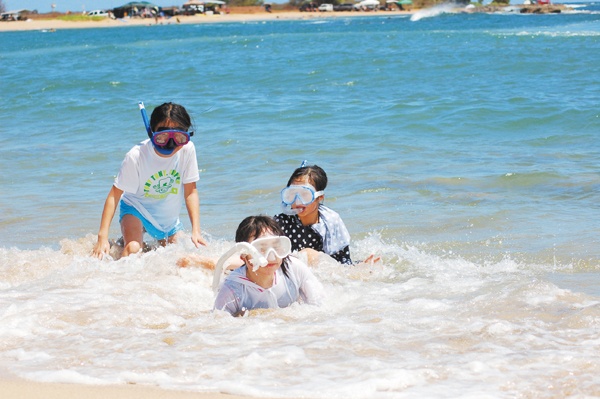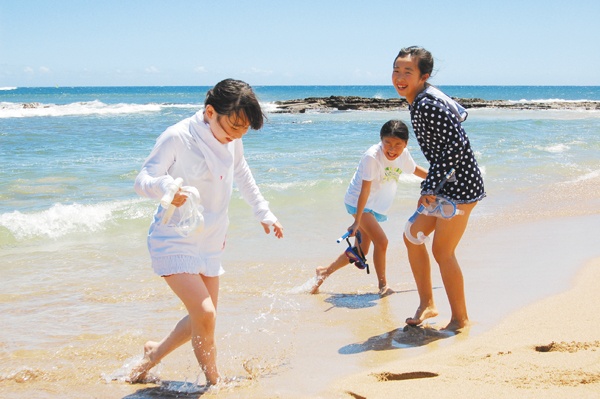WAIMEA — Lynn Sasaki, Ayaka Itabashi and Minami Tsunokake spent their first full day on Hawaii — and first trip outside of Japan — like many other children would. The three 10- to 11-year-old girls laughed and played in the
WAIMEA — Lynn Sasaki, Ayaka Itabashi and Minami Tsunokake spent their first full day on Hawaii — and first trip outside of Japan — like many other children would.
The three 10- to 11-year-old girls laughed and played in the waters at Salt Pond Beach Park in Hanapepe and visited Kokee State Park on Saturday and still have a full schedule for the next six days of their stay on Kauai, including visits to Poipu and the Waipa Foundation.
But unlike many visitors who arrive on the island to leave their worries behind, these children are here to recover from physical and emotional challenges they face at home in Fukushima.
Rev. Noriaki Fujimori of the Waimea Higashi Hongwanji said the chidren are the first recipients of efforts spearheaded by Team Nihonmatsu, a Fukushima-based nonprofit, to provide a brief respite to local children so their bodies can recover from the radiation’s lingering effects.
“There are some good people with good will like this community that invited us to visit so our children can spend some time away from the affected area,” Team Nihonmatsu Founder Rev. Michinori Sasaki of Nihonmatsu City said in Japanese through translator Kyoko Ikeda, a Kauai Community College faculty member on Saturday.
“Since the accident, children are living a very stressful life. Children are just full of life and want to live fully — full of ‘genki,’ as we say — and that’s all we want, but in Fukushima, we’re not able to give our children that opportunity.”
Fukushima was one of the cities hit hardest by the 2011 tsunami and earthquake and the resulting fallout from Tokyo Electric’s Fukushima Daiichi nuclear power plant.
Their visit, coordinated by volunteers from local nonprofit Aloha Fukushima Keiki and the Waimea Higashi Hongwanji, also includes a three-day visit on Oahu.
“When I go to Japan, I always went to Fukushima,” Fujimori said. “When I found out that this was actively happening, I wanted to help start the program to bring children here to Hawaii.”
Sasaki said he was able to visit Chernobyl — the site of the world’s worst confirmed nuclear disaster — in May to learn about what can be done to help protect residents living in Fukushima.
It was there that Sasaki came up with the idea for the exchange program, which is modeled after an existing Ukrainian government law that requires children living near Chernobyl to leave the area at least twice a year so their bodies can recover from potential radiation effects.
But simple solutions, Sasaki said, are not easy to come by.
Divisions among other residents, relatives, food producers and the Japanese government have become complicated over the years and stem from a number of issues ranging from a lack of disclosed information to distrust.
“The impact that the radiation and the nuclear power plant has had on Fukushima is becoming increasingly complicated,” Sasaki said. “To simplify what the radiation has done to the people and the land in Fukushima, the radiation has continued to destroy what is important to us. The radiation has been destroying the connection that used to bind us together — there are more conflicts and greater divisions.”
What has been most difficult for many residents, Sasaki said, is the burden of feeling responsible for what has happened — like the parents, especially mothers, who unknowingly exposed themselves and their small children to radiation when there were no utilities and they had to retrieve their own water from water trucks.
It is a feeling that haunts Sasaki.
“It may sound funny, but I started to think that may be radioactive materials wasn’t such a bad thing,” “It was created in this world because of human greed for more, more and more — it is a reflection of the darkness that lies within the deepest part of our being. So, in a way, I started to think that it wasn’t such a bad thing, because it helps us see the darkness that is within each and every one of us and help us question the human history of repeating such a mistake.”
But, Sasaki said, there is still hope.
“It is my daily hope and prayer that there is a world where we can overcome those conflicts and challenges,” Sasaki said. “It’s a world where we find a way to realize our interdependence with each other. I hope that in that world each and every one of our lives glow with joy.”
Sasaki will be the guest speaker at another public talk on the current state of Fukushima at 6 p.m. July 25 in Moloaa.
For more information, contact Aloha Fukushima Keiki at: 645-0237 or alohafukushimakeiki@yahoo.com.
• Darin Moriki, staff writer and photographer, can be reached at 245-0428 or dmoriki@thegardenisland.com.



